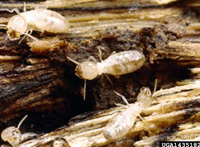Two billion years ago, in a far-away galaxy, a giant star exploded, releasing almost unbelievable amounts of energy as it collapsed to a black hole. The light from that explosion finally reached Earth at 6:37 a.m. EST on March 29, igniting a frenzy of activity among astronomers worldwide. This phenomenon has been called a hypernova, playing on the name of the supernova events that mark the violent end of massive stars.
With two telescopes separated by about 110 degrees longitude, the Roboti
A team of Carnegie Mellon University and NASA scientists will travel to the Atacama Desert in northern Chile in April to conduct research that will help them develop and deploy a robot and instruments that may someday enable other robots to find life on Mars. The researchers will be using the Atacama, described as the most arid region on Earth, as a Martian analog.
The group is funded with a $3 million, three-year grant from NASA to the university’s Robotics Institute. They are collabo
Mobile DNA’s role in vancomycin resistance of Enterococcus faecalis
‘Jumping’ elements of DNA have enabled the bacterium Enterococcus faecalis to acquire stubborn resistance to a range of antibiotics – including a “drug of last resort” that is used against such bacterial pathogens.
That is one of the conclusions reached by scientists at The Institute for Genomic Research (TIGR), which sequenced and analyzed the complete genome of E. faecalis V583, a strain of the
Early on the morning of 30 June 1908, the vast forest of western Siberia was illuminated by a strange apparition: an alien object streaking across the cloudless sky. White hot from its headlong plunge into the Earth’s atmosphere, the intruder exploded about 8 km above the ground, flattening trees over an area of 2000 square kilometres.
Despite the huge detonation, equivalent to a 10 megaton nuclear warhead (about 500 times the energy of the Hiroshima atomic bomb), there were few if any casu
Drivers talking on cell phones are nearly twice as likely as other drivers involved in crashes to have rear-end collisions, according to a new University of North Carolina at Chapel Hill study. Crashes involving cell phone use, however, are less likely to result in fatalities or serious injuries than crashes not involving the devices.
Almost 60 percent of licensed N.C. drivers have used a cell phone while behind the wheel, investigators from the UNC Highway Safety Research Center (HSRC) fo

Known for its intoxicating effects on felines, catnip oil may also have a future in termite control. Recent experiments by USDA Forest Service researcher Chris Peterson show that catnip oil repels and even kills termites in a laboratory setting.
Peterson, a researcher with the Forest Service Southern Research Station (SRS), and fellow researcher Janice Ems-Wilson, a chemist at Valencia Community College in Orlando, FL, presented the results of their research at the national meeting of the Am